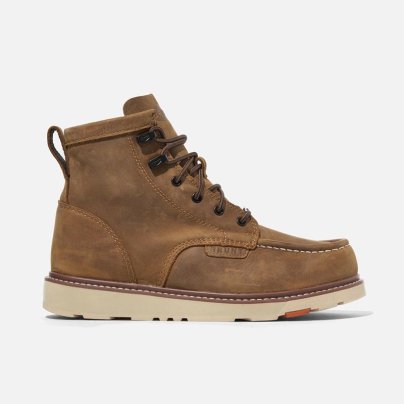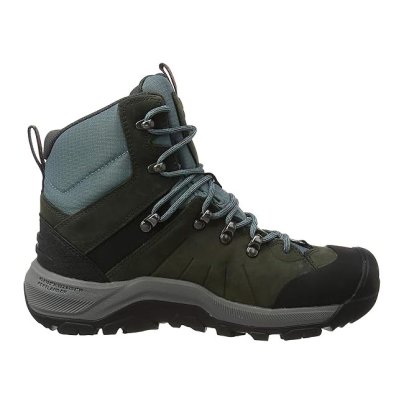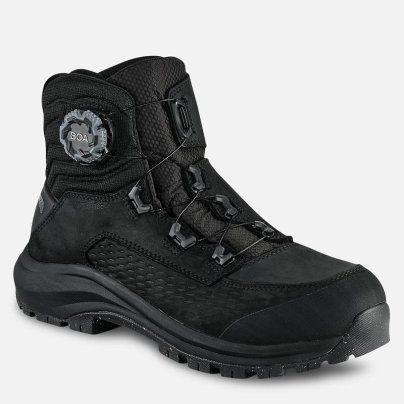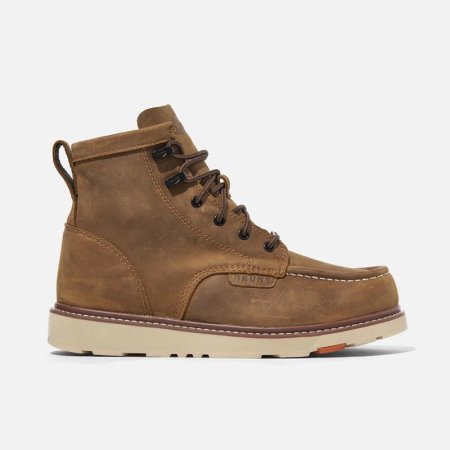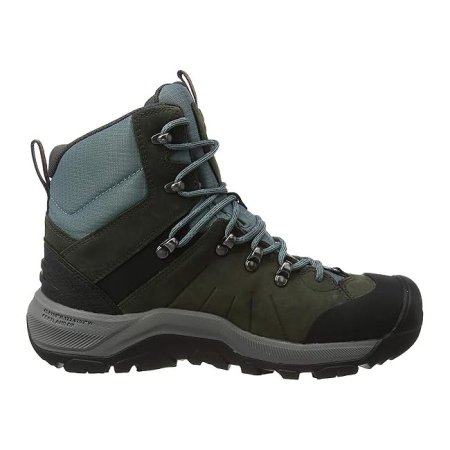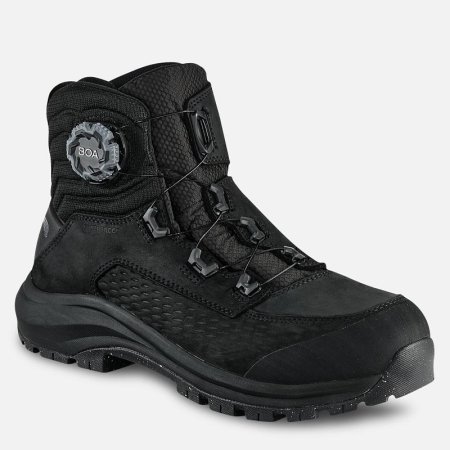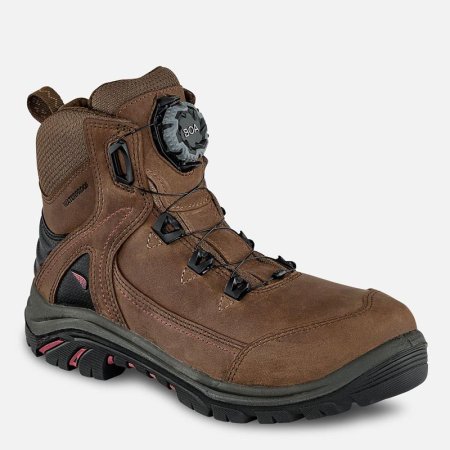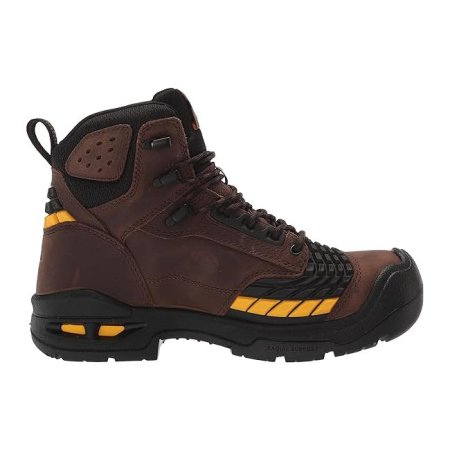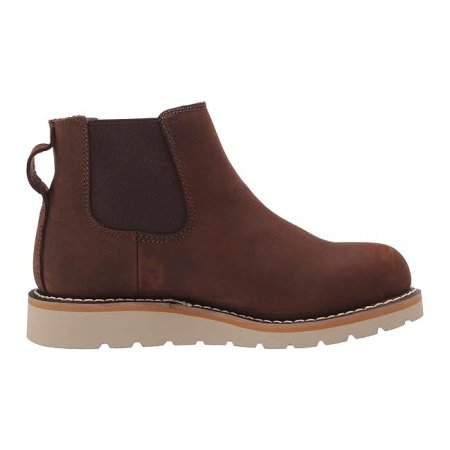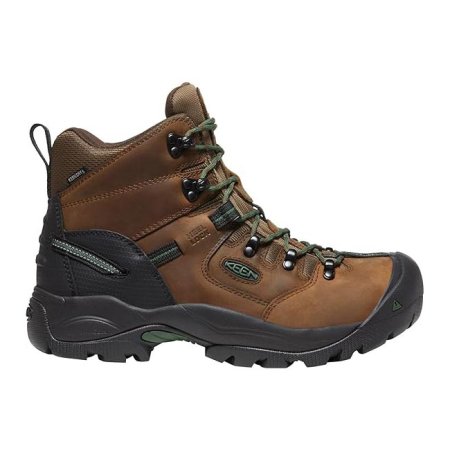
We may earn revenue from the products available on this page and participate in affiliate programs. Learn More ›
While any pair of brand-new work boots may look great, the right pair of work boots will protect your feet from injury, provide support, and be comfortable and durable enough to wear during a long day of standing and walking. Our test team researched over 50 pairs of work boots and then chose seven pairs for testing. We pulled them on, laced them up, and wore them in real-life work situations to determine how well they resisted water, withstood punctures, and protected our toes from dropped items.
Both hazards and footwear needs vary from job to job. However, if you’re looking for work boots that will support and protect your feet all day, keep reading to discover how each pair performed in our hands-on testing and which ones are the top picks for the best work boots in various categories.
- BEST OVERALL: Brunt The Marin 6″ Unlined Comp Toe Work Boot
- BEST BANG FOR THE BUCK: Keen Revel IV Polar Waterproof Boot
- BEST WATERPROOF: Red Wing Apex 6″ BOA Waterproof Safety Toe Boot
- BEST WOMEN’S SAFETY TOE: Red Wing Tradeswoman 6″ Waterproof Safety Toe Boot
- BEST NON-STEEL TOE: Keen Troy 6″ Waterproof Carbon-Fiber Toe Boot
- BEST WOMEN’S SOFT TOE: Carhartt Chelsea Wedge Boot
- BEST COMFORT: Keen Pittsburgh Energy 6″ Waterproof Boot
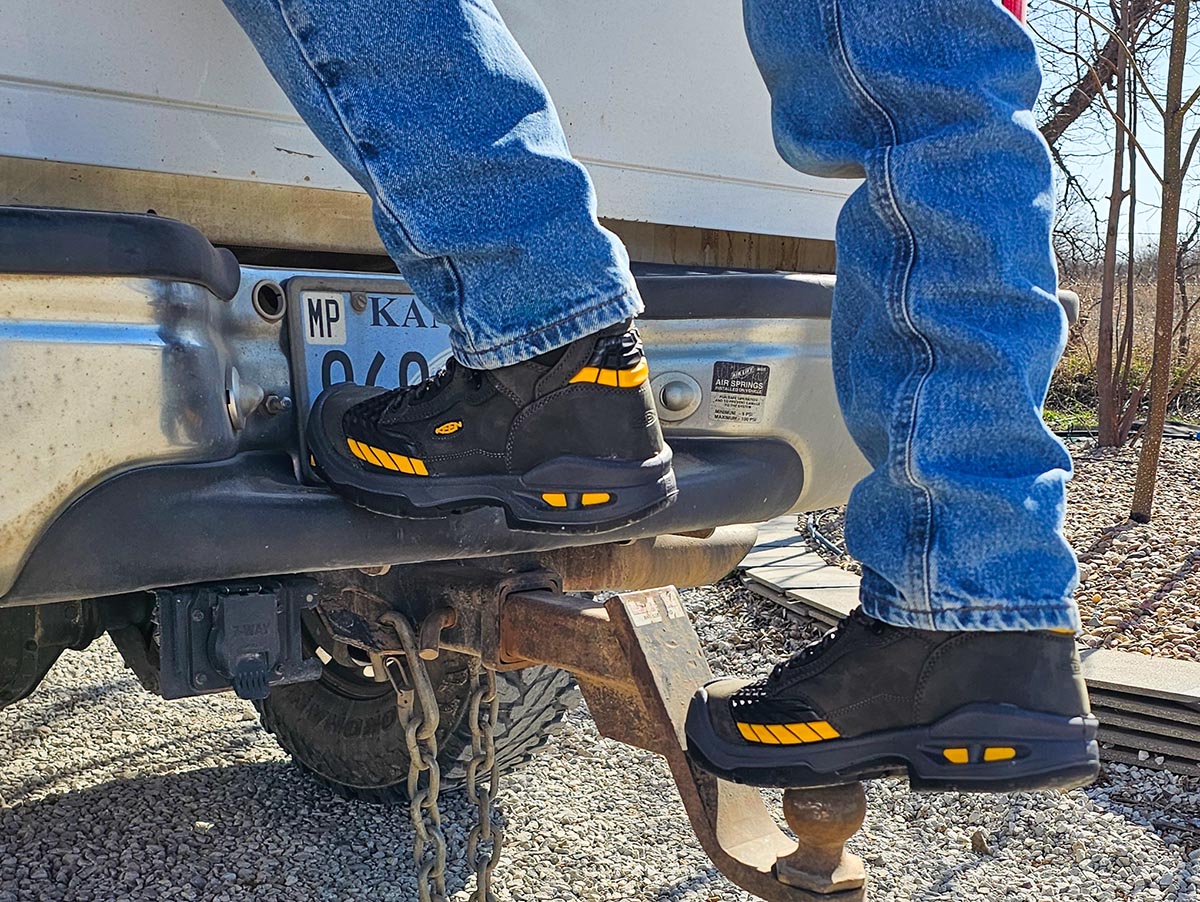
How We Tested the Best Work Boots
Before selecting the work boots for our testing, we researched more than 50 high-quality pairs, recording their attributes, material quality, and consumer satisfaction. We naturally considered certain brands—after all, well-known manufacturers like Red Wing Shoes, Keen, and Carhartt have long been associated with top-notch boots and workwear. We further narrowed our list by selecting boots with a variety of protective purposes.
Our testers wore the boots as they would on a typical workday. They noted the break-in period of the boots (if necessary) and the overall comfort level. Then, they tested the manufacturer’s claims. For example, if the manufacturer advertised the boots as waterproof, the testers walked through shallow puddles, stood in a sprinkler, or even submerged their feet. If the boots were supposed to be puncture-resistant or protect feet from dropped items, the testers walked on sharp tacks or dropped weights on their toes, respectively. They also noted the slip resistance of the boots and whether they ran true to size.
For each test, we awarded points to the work boots based on a rubric. The better they performed in each test, the more points they received. After testing, we averaged the points and noted the pros and cons of each pair to help us determine whether it deserved a spot in our top picks and—if so—in which category it best fit.
Testing Stats
- Products tested: 7
- Hours spent testing: 2 to 5 days (8-hour workdays)
- Tests performed: 5
- Average price: $185
Our Top Picks
When it comes to work boots, there’s no one-size-fits-all pair. Everyone’s feet are different, and so are job hazards and requirements. But whether you need strong ankle support, water resistance, or a safety toe, you’ll find that the best work boots are made from durable materials and feature quality assembly. Our top picks feature work boots for men and women—there is sure to be a pair that will offer comfort, support, and safety throughout the workday.
Best Overall
Brunt The Marin 6" Unlined Comp Toe Work Boot
Product Specs
- Boot type: Lace-up
- Materials: Leather, rubber, polyurethane
- Toe type: Composite
- Special ratings: ASTM 2413-18, ASTM F2913-19, ASTM F1677-96, ASTM D47-06 903, EH
This Bob Vila Approved product carries our brand’s highest level of recommendation.

Bob Vila Approved recognizes the household and DIY products that impressed us most in our real-world testing and that exemplify core values of the Bob Vila brand, including craftsmanship, innovation, and value for the dollar. Winners of this designation come recommended by our professional review team and are personally approved by Bob Vila.
Our Ratings: Comfort 4.5/5; Water Resistance 5/5; Protection 5/5; Traction 5/5; Value 4/5
What We Like
- Lightweight and comfortable fit; suitable for extended wear right out of the box
- Adjustable for different foot shapes and sizes due to a multilayer insole
- Durable construction ensures long-lasting wearability and added value
What We Don’t Like
- Lack of lining and rigid tongue may create friction between boot interior and sock
- High-profile toe area feels clunky; boots are a bit large in this area
The Marin work boots from Brunt are sturdy, affordable boots that wear well right out of the box. They boast timeless moc toe wedge styling, a 6-inch shaft made of tough barnyard-resistant leather, a lightweight safety toe, and a slip-/oil-/heat-resistant rubber outsole. The unlined edition that we tested offers maximum breathability for warm climates or indoor work and carries ASTM (American Society for Testing and Materials) ratings for slip resistance, oil resistance, compression, and electrical hazards.
We wore these work boots for 40 hours of outdoor testing, on and off the pavement. We removed the lower insole layer to provide extra width with thick socks before lacing on the boots. Later, we reinserted the lower insole for use with regular boot socks. The boots fit well and were comfortable right away; only the tongue needed time to break in as it felt a bit rigid throughout the week.
These Brunt boots feature top-notch quality and comfort for the price. They offered excellent support for standing and working in one place. The relatively flat soles were comfortable for long hours of standing on pavement and also provided good flexibility and spring for walking work.
Since these boots are only rated “water resistant,” they are not an ideal pick for constant water exposure. However, for a general-purpose, medium-duty work boot, it’s hard to find a better value.
Get the Brunt Marin work boots at Brunt, Blue Collar Workwear, or Lehigh Safety Shoes.
Best Bang for the Buck
Keen Revel IV Polar Waterproof Boot
Product Specs
- Boot type: Lace-up
- Materials: Leather, Keen Polar traction, PET recycled plastic
- Toe type: Soft (non-safety)
- Special features: Antimicrobial, insulated, padded lining
Our Ratings: Comfort 4.5/5; Water Resistance 5/5; Protection 5/5; Traction 5/5; Value 5/5
What We Like
- Provide warmth and insulation in cold temperatures without making feet sweat
- Good ankle support for walking on uneven terrain safely
- Waterproof exterior prevents feet from getting wet when working in damp grass and shallow puddles
- Antimicrobial liner helps reduce foot odor even after extended wear
What We Don’t Like
- Insulation might make it a less attractive option for working in hot temperatures
Women looking for a pair of protective work boots for winter need not spend a fortune. The Keen Revel IV waterproof boots are made to protect feet and support ankles at an affordable price point.
The boots don’t feature a standard safety toe, but we found the toe box firm enough to protect against stubs and lightweight dropped items. We wore the boots outdoors on wet grass to see if the soles would slip, but they offered excellent traction, making it difficult to even purposefully slide on the slick surface.
We also did yard work while the sprinkler sprayed our lower legs and boots. After 30 minutes, we removed the boots—our pant legs were soaked, but the boots were dry except for the top section above the ankle.
These insulated boots kept our feet warm on chilly mornings. They run true to size, and the soles resisted punctures. While these are good work boots for cold weather, when the daytime temperatures heated up, so did our feet. If you’re looking for strictly warm-weather boots, these might not be the best option.
Get the Keen Revel IV work boots at Amazon, Duluth Trading, or Keen.
Best Waterproof
Red Wing Apex 6" BOA Waterproof Safety Toe Boot
Product Specs
- Boot type: Lace-up, BOA dial
- Materials: Vibram, cellulose fiber, EVA footbed
- Toe type: Aluminum safety toe
- Special ratings: F2413-18 M/I/C, Mt, EH, SD 35, PR; F2892-18 EH; F3445-21 SR
Our Ratings: Comfort 4.25/5; Water Resistance 5/5; Protection 5/5; Traction 4/5; Value 3/5
What We Like
- Short break-in period and comfortable fit similar to hiking boots
- Aluminum toe box adds safety without creating undue weight
- Lightweight waterproof construction
What We Don’t Like
- Pricier than most of the other work boots we tested
If you prioritize comfort and walkability with a full range of safety features, Apex work boots from Red Wing Shoes could be a perfect option. These ultra-lightweight waterproof safety boots fit and feel more like hiking boots. They feature cement construction, aluminum safety toes, recycled Vibram soles, and soft nubuck leather uppers for safety and support with an extremely short break-in period.
These work boots were some of the lightest boots we tested at just under 3 pounds. We loved the comfortable yet supportive fit that was enhanced by the unique BOA Fit System. The system incorporates a series of low-friction guides and super-strong wire laces secured with a micro-adjustable dial. Twisting the dial adjusts the fit along the entire contour of the foot, creating a personalized fit with no rubbing or sliding. We could take them on and off in seconds without actually tying them.
After wearing the boots for more than 40 hours of landscaping and tree-cutting work, we were pleased with the results. The soft leather and cement construction was extremely comfortable from the start and only got better with wear. The waterproofing capability held up well during rainy, muddy days. The only question as yet unanswered for us is: How long will they last? At a price of more than $250, their working life will hopefully stretch beyond 2 years.
Get the Red Wing Shoes Apex work boots at Red Wing Shoes.
Best Women’s Safety Toe
Red Wing Tradeswoman 6" Waterproof Safety Toe Boot
Product Specs
- Boot type: Lace-up, BOA dial
- Materials: Leather, polyurethane insole, rubber outsole
- Toe type: Carbon-fiber safety toe
- Special ratings: F2413-18, EH
Our Ratings: Comfort 4/5; Water Resistance 5/5; Protection 5/5; Traction 5/5; Value 4/5
What We Like
- Cushioned ankle moves with the wearer and provides ample support
- BOA Fit System makes boots easy to tighten, even while wearing gloves
- VersaTrax rubber sole offers superior traction on slippery, uneven surfaces
- Fit is roomy enough for thick work socks and the wearer’s preferred insole
What We Don’t Like
- Sturdy sole requires ample break-in period for optimal comfort
- Lacing system may not be ideal for those with a high instep
The Red Wing Shoes Tradeswoman work boots can withstand just about any test. The manufacturer has tested the composite safety toe to protect users from 75 pounds of force. These leather work boots are waterproof, and their thick rubber soles are slip- and puncture-resistant. They also feature a BOA Fit System for easy, click-and-twist dial lacing—similar to those on cycling shoes.
We were impressed by the ruggedness of these work boots from the beginning of our testing. First, they withstood submersion up to the laces in both a tub and large muddy puddles. Then, they maintained traction on a muddy hill and a variety of other hard, wet surfaces. The composite toes absorbed the impact of the kettlebells we dropped on them. Plus, even though they’re not rated for puncture resistance, the soles were thick enough to withstand smaller sharp objects in our tests.
However, all that durability can have its disadvantages. The rugged soles don’t lend themselves to these being comfortable work boots, as they take time to break in. While we liked the functionality of the dialed laces, they tighten evenly all over, so users with high insteps would have to slide a couple of fingers under the bottom two rows of laces to prevent overtightening.
Get the Red Wing Shoes Tradeswoman work boots at Red Wing Shoes or Winterport Boot Shop.
Best Non-Steel Toe
Keen Troy 6" Waterproof Carbon-Fiber Toe Boot
Product Specs
- Boot type: Lace-up
- Materials: Leather, PolyAer, rubber
- Toe type: Carbon-fiber safety toe
- Special ratings: ASTM F3445-21, F2413-18 M I/75 C/75 EH, ASTM F1677-96 Mark II, ASTM D471-06 903
Our Ratings: Comfort 5/5; Water Resistance 4.7/5; Protection 5/5; Traction 5/5; Value 4/5
What We Like
- Carbon-fiber toe box increases protection without adding weight
- Comfortable fit that doesn’t require a significant break-in period
- Lightweight, flexible construction and fused uppers for durability
What We Don’t Like
- Pricier than most of the other work boots we tested
Keen serves up another winner with these men’s work boots. The Troy waterproof boots feature carbon-fiber toe boxes to prevent injuries, and they’re extremely lightweight at just 1.86 pounds for the pair.
The boots were one of the few models we tested that didn’t require at least some break-in period to be comfortable. From the moment we put them on, they felt like well-worn friends. These American-made work boots offer several high-end attributes, including flexible construction, carbon-fiber toes, and fused uppers for a longer-lasting bond than glue or solvents provide.
We tested the Troy work boots for a full workweek, and during that time, we were on pitched roofs and mucking around the farm in puddles and wet grasses. These well-made boots kept our feet dry and even stepping on barbed wire didn’t puncture them.
While these are exceptional boots, they’re also pricier than most of the other pairs we tested. Only time will tell if they will withstand the use and abuse of our typical workdays.
Get the Keen Troy work boots at Amazon, Cabela’s, or Keen.
Best Women’s Soft Toe
Carhartt Chelsea Wedge Boot
Product Specs
- Boot type: Pull-on
- Materials: Leather, polyurethane, rubber
- Toe type: Soft (non-safety)
- Special ratings: ASTM F2892-18, EH, ASTM F3445-21, SR
Our Ratings: Comfort 3.7/5; Water Resistance N/A; Protection 4/5; Traction 5/5; Value 3.5/5
What We Like
- Versatile style suits work and casual social settings
- Easy to slip on and off even with gloves or messy hands
- Sturdy sole provides excellent traction on a variety of surfaces
- Soft toe still provides some protection against stubbing
What We Don’t Like
- Wide fit may not suit some users
- Stiff sole takes several hours to break in
- Not water-resistant
These Carhartt Chelsea wedge boots provide the durability of a work boot in an on-trend style, highlighted by an oil-tanned leather upper with a contrasting gold and cream sole. But these boots are about more than looks. Stretch panels on the side and a loop on the back make getting these boots on and off a cinch. They’re also rated for electrical hazard protection and slip resistance.
While these are light-duty work boots, we still found them to be quite sturdy in our tests. Though technically considered soft-toe work boots, they protected our toes from bumps and the impact of lightweight objects up to 3 pounds. We also got traction quite easily on wet inclines and even on wet composite decking.
However, these attractive pull-on work boots weren’t without their pitfalls. First, they are somewhat wide work boots, particularly on the heel. This looser fit caused quite a bit of slippage when we were walking. We were also surprised that they took several hours to break in; they appeared more flexible than they actually were in testing.
Since the boots don’t provide additional safety features, such as impact or puncture resistance, we would have preferred they offer at least some water resistance to make them more functional and a bit better value. Still, if you’re looking for a light-duty but sturdy work boot—that also happens to be stylish—these Carhartt boots could very well fit the bill.
Get the Carhartt Chelsea work boots at Amazon (wide), The Home Depot (medium), or Tractor Supply Co. (wide).
Best Comfort
Keen Pittsburgh Energy 6" Waterproof Boot
Product Specs
- Boot type: Lace-up
- Materials: Leather, rubber, PU
- Toe type: Carbon-fiber safety toe
- Special ratings: ASTM F3445-21, F2413-18 M I/75 C/75 EH, ASTM F1677-96 Mark II nonslip, ASTM SATRA TM31, ASTM D471-06 903
Our Ratings: Comfort 5/5; Water Resistance 5/5; Protection 5/5; Traction 4/5; Value 5/5
What We Like
- Comfortable right from the start; no break-in period necessary
- Excellent fit, easy to slip on, and rubber midsoles made for smooth walking
- Carbon-fiber toe keeps the boot lightweight but offers protection
What We Don’t Like
- Pricier than some of the other work boots we tested
We wore this pair of Keen Pittsburgh boots for 2 days straight during a range of weekend adventures and were very impressed with how comfortable they were right away. They slipped on easily, and the overall fit was as secure as it was comfortable.
After a 1-hour drive to a hiking trail and the 4-hour hike, we expected some blisters from a brand-new pair of boots, but we experienced nothing of the sort. The middle sole layer is a spongy rubber that provides a very smooth walking experience, so long hours on a jobsite can be less tiring with these boots cradling your feet.
They also fit the bill as protective yet lightweight work boots, thanks in part to the carbon-fiber toe box (instead of heavier steel) that withstood our tests of dropping 10-pound dumbbells onto our toes.
IN addition, these Pittsburgh work boots are also fully waterproof, which we tested by standing in a bucket of water for 15 minutes. The tongue is sewn all the way to the top of the boots to keep your feet dry if you are wading through water. We also felt secure on slippery surfaces while wearing these boots. The hard rubber soles are oil- and slip-resistant with plenty of textured grooves and tracks to provide a good grip, even when walking up a wet grassy hill as we did during our testing.
Get the Keen Pittsburgh work boots at Amazon, Cabela’s, or Keen.
Jump to Our Top Picks
What to Consider When Choosing Work Boots
Comfort, durability, and safety are top priorities when it comes to boots for work in outdoor or even dangerous environments. Individual needs vary, but some factors remain constant—work boots should offer a comfortable fit, provide water resistance and breathability to keep feet dry, support the feet and ankles, and insulate feet from cold temperatures. Consider the following attributes before buying.
Materials
Most, but not all, work boots feature leather uppers because leather is durable and offers protection against lateral punctures and tears. On the downside, leather can be heavy, so some manufacturers use leather for the parts of the uppers that need the most protection and incorporate lightweight synthetic materials along the tongue for breathability.
Rubber is the most common material for outsoles due to its high degree of slip resistance. Some older-style boots feature hard leather soles, but they can be slippery, and the boots may need an extended break-in period.
If you prefer lightweight work boots but require protection from dropped items, consider boots with a carbon-fiber toe rather than traditional steel toe boots. Carbon-fiber toes are strong and offer ample protection, but their lighter weight makes them more comfortable.
Waterproofing and Insulation
Waterproofing, or at least a measure of water resistance, is desirable in work boots exposed to wet conditions. Membranes, such as Gore-Tex, prevent water from permeating the boots. However, the downside to completely waterproof boots is reduced breathability, which can lead to smelly boots and cause sweaty feet and other potential foot problems. A happy medium is more breathable work boots that feature water-resistant uppers, sealed soles, and lining on the boot’s upper tongue.
Boots for pouring concrete are typically fully waterproof slip-on boots to prevent wet concrete from touching the skin and causing irritation. Muck-type boots are often best to keep in an entry closet or by a front door to pull on quickly.
Those who work outdoors in cold weather will likely prefer an insulated lining like Thinsulate, which helps keep feet warm but can also add undesirable bulk to the boots.
Support and Comfort
Comfort is vital in work boots, especially for wearers who spend long hours on their feet. In some jobs, foot and ankle support is crucial, but this is a fine line. You may want supportive boots when working on uneven terrain or lifting heavy items, but overly rigid boots can limit mobility and pinch calves and feet. Generally, the best work boots offer a balance of support, comfort, and flexibility—all three are essential for productive and pain-free workdays.
Trying on work boots before buying is optimal, but since many boot types are only available online, consider the retailer’s return policy. Boots in many brands—but not all—run true to size, so read customer comments before buying in case you need to size up or down.
Safety Features
Steel or carbon-fiber toes are some of the most common safety features in work boots, along with ankle support to reduce twisted or sprained ankles.
Today’s manufacturers are constantly improving their boots’ safety features, and many of those attributes are rated by the American Society for Testing and Materials (ASTM). Dozens of ratings may apply to individual boots, such as a rating of ASTM D471-06, which means the boot resists water, to an EH rating, which means the boot will withstand some electrical hazards.
In addition to the special ratings, most manufacturers will explain their boots’ safety attributes, but check out the ASTM website for clarification.
FAQs
Many work boots are pricey, so it pays to be an informed shopper. Some of the more common questions we’ve heard—and their answers—are below.
Most work boots should last between 6 months and 2 years, depending on their quality and the type of work they’re subjected to.
If your feet hurt after wearing work boots, it could be due to improper fit, too little cushioning, or lack of support.
Neither. Work boots should fit comfortably with enough room for your toes to wiggle but not so much room for the boots to slide and cause blisters.
